|
Gloster Meteor Mk. IV
“World Speed Record”
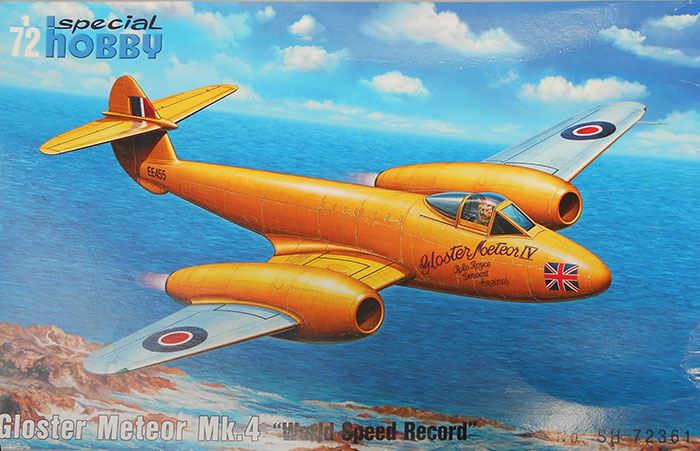
Special
Hobby, 1/72
S u m m a r y
|
|
Catalogue Number: |
Special Hobby Kit No. SH72361 - Gloster Meteor Mk. IV “World Speed Record” |
|
Scale: |
1/72 |
|
Contents and Media: |
Three grey sprues of parts; one small clear sprue; a pair of PE intake guards; a plastic sleeve with the decals; onea set of canopy masks. |
|
Price: |
GBP£16.99 EU Price (GBP£14.16 Export Price) plus shipping available online from Hannants
18,90 € plus shipping available online from Special Hobby |
|
Review Type: |
FirstLook |
|
Advantages: |
Conforms to published plans; fine panel
lines, extensive detail; busy wheel wells
and clever engine mounting; high quality
markings. |
|
Disadvantages: |
Accuracy issues regarding decals and colour callouts. |
|
Recommendation: |
This is a lovely kit from which you can produce a lovely model and there are so many possible schemes besides the ones provided in the box. |
Reviewed by
Graham Carter

Special Hobby's 1/48 scale Model 339-23 Buffalo will be available
online from Squadron
Originally released under the MPM label in 2009, reboxed by Special Hobby in 2010, and shared with Revell around the same time, this kit has been available in a number of versions, both RAF and Belgian. It is pre-dated by the FROG F4 in 1970, a pretty fair rendition for the time, and by a limited-run PJ Productions in 1999, about which I know nowt. It is a kit of an aeroplane that fits well into my area of interest.
I won’t give too much background for such a well-known aeroplane but this twin-engined fighter was jointly developed by Frank Whittle’s Power Jets Limited and the Gloster Aircraft Company, first flown in March 1943 and 616 Squadron commenced operations on the type in July 1944. Originally the RAF used the Mk I and III versions of this new aircraft to combat the threat of V-1 flying bombs. The Mk. IV was the first major post-war variant. It was powered by Derwent 5 engines, housed in longer nacelles and originally retaining the longer span wings for the MK III. Although additional wing strengthening was incorporated into the new design, but was found to be insufficient and clipped wings were introduced in order to reduce stress on the airframe, resulting in improved manoeuvrability but reduced rate of climb and service ceiling.
Its speed potential led the RAF to consider attempts on the World Speed Record in the year immediately after the war.
This version of the kit represents the four aeroplanes that were used to set a number of speed records. Apart from the well-known “Forever Amber’ or ‘Yellow Peril’, there are provisions for two so-called Star Meteors and ‘Britannia’, also used to set various records.
Peter Mitchell did a review of the original MPM version some years ago on HyperScale and I have nothing to add to that for the standard kit.

Sealed in MPM/Special Hobby’s familiar re-sealable plastic bag are 3 grey sprues of parts ( two of them being from the standard Mk IV release kit), one small clear sprue, and a plastic sleeve with the decals, a pair of PE intake guards (called ‘Gaunt Guards’ after a certain LAC Gaunt, who was partially sucked into the mouth of a Derwent undergoing ground running - this I found out after posting a question to Mike Hooks at Aeroplane Monthly) and a set of canopy masks.
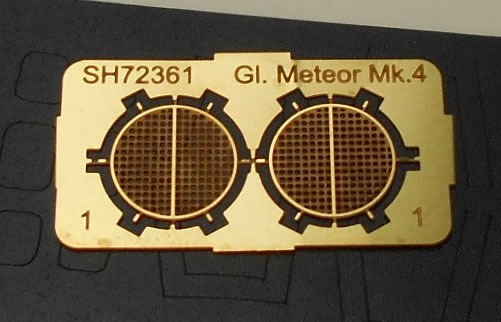
The extra sprue is from the Meteor PR10 kit and contains the longer span outer wing panels needed for the speed Meteors. This sprue is slightly grainy in texture compared with the standard F IV plastic parts.
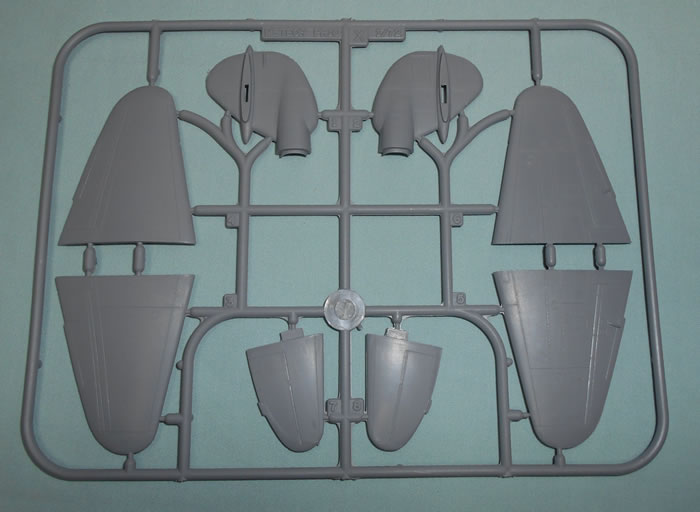
There are a few parts not needed , such as the spare elevators and tail from the PR10 sprue and the fuel tanks from the F IV . Parts are all nicely moulded with subtle panel line detail as we have come to expect from this not-so-short-run company. I was pleased to see location pins for many parts. Previous experience with a PR10 kit showed that it goes together really well.
Points to watch for, however, include the provision of incorrect main wheels and the butt-joint of the u/c legs to the u/c bay roofs. The latter can be strengthened with a pin but the main-wheel issue is a problem for the pedant. The kit has the later standard 8-hole wheels, but all the photos of the Speed Meteors that I have seen show the use of four radially slotted wheels, with the possible exception of EE549, currently displayed at Tangmere - I will have a look next July as I will be visiting this museum then. A quick fix is to use a pair of slightly thinned down Fairey Firefly wheels as these have the correct wheel slot pattern and diameter.
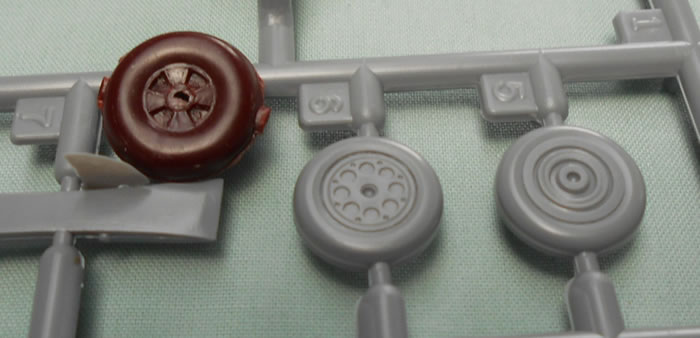
Also check the use of the dorsal aerial, as only the more standard later EE549 will have it in place.
Note that you will have to fill the cannon holes and very carefully sand the barrel- bulges off (I would mask the area around them). None of the original record setters carried the belly tank, only EE549 in its Paris-London dash had it in place. Don’t forget to add nose weight as this airframe is definitely a tail-sitter, the intructions mention the need but not the quantity - about 5g will do.
The lower edge of opening canopy section also needs to be extended upwards as this was strengthened in the originals - this is explained in the instructions.
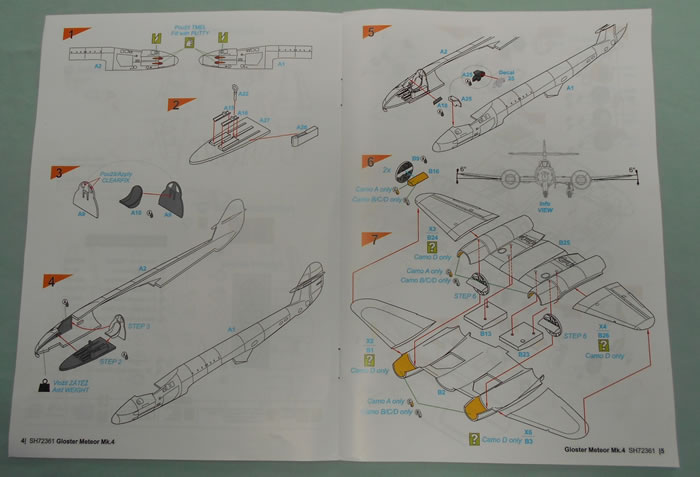
Decals are provided for the four record setting High Speed Flight Meteor schemes and three aircraft:
-
Meteor EE455, a Mk.III converted to a Mk.IV and flown by Gloster Chief Test Pilot Eric Greenwood
-
Meteor EE454, another Mk.III converted to a Mk.IV and flown by Wing Commander Hugh Joseph Wilson, AFC and two Bars, who achieved a speed of 606 mph on 7 /11/1945. Known as the
-
Meteor EE549 in two versions, as
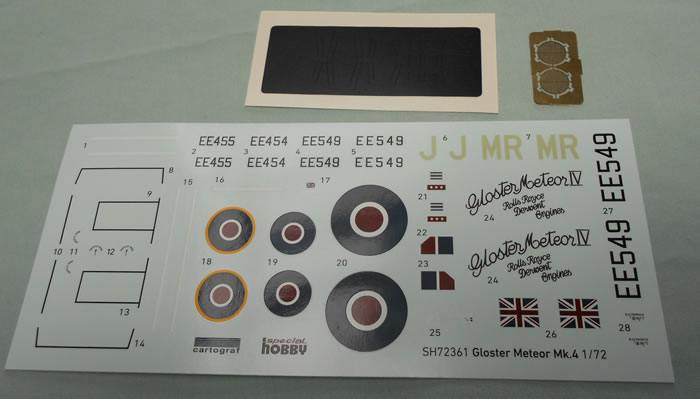
EE455 was yellow, and EE454 and the early version of EE549 were in highly polished Ocean Grey/Dark Green over Medium Sea Grey camouflage with sky fuselage bands. EE454, EE549 and another, EE550, were known as ‘Star Meteors’ and all lacked aerials and cannon.
Colours and Decals - the Fun Begins!
There are no problems if you are building the highly polished and camouflaged EE454 and EE549, just make sure you remove the cannons and are careful about the canopy section. The fun is in the colour interpretation of EE455, also known as ‘Forever Amber’ and ‘Yellow Peril’. Much discussion has taken place on Britmodeller concerning the colours of the horizontal surfaces, and the kit instructions and box-top reflect this.
Three sets of decals by ModelArt (#72-002), Kits World ( KW172098) and Kits at War/Dutch Decals ( K7/3) all indicate that the plane was overall yellow. This is supported by articles in Aeroplane Monthly October 1983 and a detailed look closer to the contemporary date in Aircraft Illustrated November 1970 which all state overall yellow. The latter includes detailed drawings by A. Grainger showing all over-all yellow.
However, discussion and photo-interpretation analysis at
http://www.britmodeller.com/forums/index.php?/topic/235017378-172-gloster-meteor-mk4-world-speed-record-by-special-hobby-released/&
seems to favour the horizontal surfaces being left in natural metal, a belief reflected in the box art and instructions in the kit where, on page 9 , there is a comment that the tail should be NM as well but the info came too late to change the box again. The original box art had been overall yellow and this was changed to the version being reviewed. Much of the discussion revolves around B&W photo interpretation and we all know how frought that is. It is important to realise that articles written closer to the time than we are now all mention an overall yellow scheme. Its really up to you, but here is my version built 15 years ago using the fuselage and tail from the Airfix F3 and the wings from a Matchbox NF11-14.
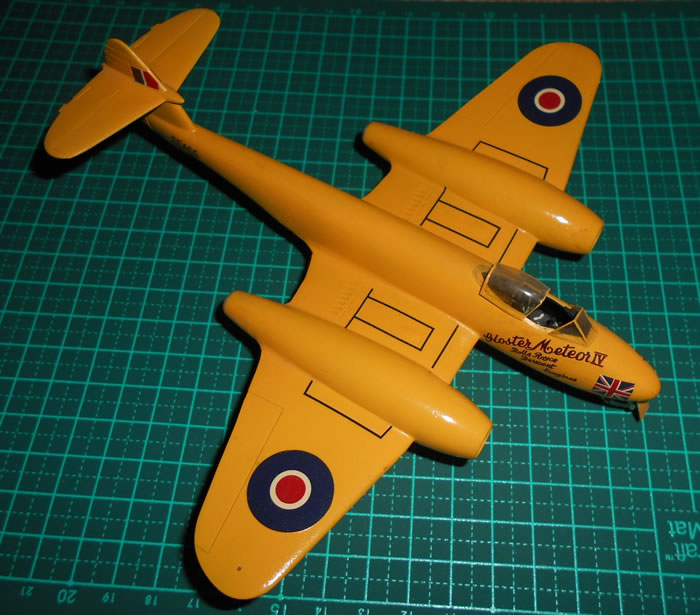

More seriously, though, the decals are incorrect in that all photos and Mr Grainger’s drawings, show that the kit Union flag decals are too square and the script on the nose , “Gloster Meteor IV , Rolls Royce Derwent Engines” should not be black, but navy blue shadowed with red. Union flags are easy enough to find, but the script? Oh boy!! Dig up the ModelArt sheet if you can as it does have the correct colours, as does, I believe, the Kits at War sheet.
Despite the above comments, which have little to do with the basic kit, this is a lovely kit from which you can produce a lovely model and there are so many possible schemes besides the ones provided in the box.
Two or three of these kits will give a varied collection out of the box, and it gives you an excuse to leave a model in a high gloss finish.
Keep buying these models as their success will hopefully encourage Special Hobby to do some of the Night Fighters!
Thanks to MPM / Special Hobby for the
review sample.
MPM
kits are available worldwide through hobby retailers
worldwide
and at
Squadron.com
Review and Images Copyright © 2017 by
Graham Carter
Page Created 7 December, 2017
Last updated
7 December, 2017
Back to
HyperScale Main Page
Back to
Reviews Page |
